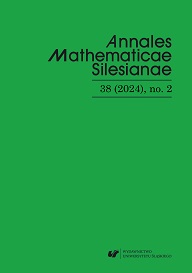W.N. Anderson and T.D. Morley, Eigenvalues of the Laplacian of a graph, Linear and Multilinear Algebra 18 (1985), no. 2, 141–145.
Google Scholar
D. Archambault, T. Munzner, and D. Auber, TopoLayout: Multilevel graph layout by topological features, IEEE Trans. Vis. Comput. Graph. 13 (2007), no. 2, 305–317.
Google Scholar
D. Archambault, T. Munzner, and D. Auber, GrouseFlocks: Steerable exploration of graph hierarchy space, IEEE Trans. Vis. Comput. Graph. 14 (2008), no. 4, 900–913.
Google Scholar
M. Arezoomand and B. Taeri, Zagreb indices of the generalized hierarchical product of graphs, MATCH Commun. Math. Comput. Chem. 69 (2013), no. 1, 131–140.
Google Scholar
L. Barrière, C. Dalfó, M.A. Fiol, and M. Mitjana, The generalized hierarchical product of graphs, Discrete Math. 309 (2009), no. 12, 3871–3881.
Google Scholar
J. Braun, A. Kerber, M. Meringer, and C. Rücker, Similarity of molecular descriptors: the equivalence of Zagreb indices and walk counts, MATCH Commun. Math. Comput. Chem. 54 (2005), no. 1, 163–176.
Google Scholar
Q. Ding, W. Sun, and F. Chen, Applications of Laplacian spectra on a 3-prism graph, Modern Phys. Lett. B. 28 (2014), no. 2, 1450009, 12 pp.
Google Scholar
M. Eliasi and A. Iranmanesh, The hyper-Wiener index of the generalized hierarchical product of graphs, Discrete Appl. Math. 159 (2011), no. 8, 866–871.
Google Scholar
M. Eliasi, Gh. Raeisi, and B. Taeri, Wiener index of some graph operations, Discrete Appl. Math. 160 (2012), no. 9, 1333–1344.
Google Scholar
J. Feigenbaum and A.A. Schäffer, Finding the prime factors of strong direct product graphs in polynomial time, Discrete Math. 109 (1992), no. 1–3, 77–102.
Google Scholar
D.C. Fisher, J. Ryan, G. Domke, and A. Majumdar, Fractional domination of strong direct products, Discrete Appl. Math. 50 (1994), no. 1, 89–91.
Google Scholar
I. Gutman and N. Trinajstić, Graph theory and molecular orbitals. Total ϕ-electron energy of alternant hydrocarbons, Chem. Phys. Lett. 17 (1972), no. 4, 535–538.
Google Scholar
R.S. Hales, Numerical invariants and the strong product of graphs, J. Combinatorial Theory Ser. B 15 (1973), 146–155.
Google Scholar
R. Hammack, W. Imrich, and S. Klavžar, Handbook of Product Graphs, CRC Press, Boca Raton, FL, 2011.
Google Scholar
Y.P. Hong, R.A. Horn, and C.R. Johnson, On the reduction of pairs of Hermitian or symmetric matrices to diagonal form by congruence, Linear Algebra Appl. 73 (1986), 213–226.
Google Scholar
A. Kaveh and H. Fazli, Approximate eigensolution of Laplacian matrices for locally modified graph products, J. Comput. Appl. Math. 236 (2011), no. 6, 1591–1603.
Google Scholar
A. Kaveh and K. Koohestani, Graph products for configuration processing of space structures, Comput. Struct. 86 (2008), no. 11–12, 1219–1231.
Google Scholar
A. Kaveh and R. Mirzaie, Minimal cycle basis of graph products for the force method of frame analysis, Comm. Numer. Methods Engrg. 24 (2008), no. 8, 653–669.
Google Scholar
M.H. Khalifeh, H. Yousefi-Azari, and A.R. Ashrafi, The hyper-Wiener index of graph operations, Comput. Math. Appl. 56 (2008), no. 5, 1402–1407.
Google Scholar
M.H. Khalifeh, H. Yousefi-Azari, and A.R. Ashrafi, The first and second Zagreb indices of some graph operations, Discrete Appl. Math. 157 (2009), no. 4, 804–811.
Google Scholar
S. Klavžar, Strong products of χ-critical graphs, Aequationes Math. 45 (1993), no. 2–3, 153–162.
Google Scholar
S. Klavžar and U. Milutinović, Strong products of Kneser graphs, Discrete Math. 133 (1994), no. 1–3, 297–300.
Google Scholar
J.-B. Liu, J. Cao, A. Alofi, A. AL-Mazrooei, and A. Elaiw, Applications of Laplacian spectra for n-prism networks, Neurocomputing 198 (2016), 69–73.
Google Scholar
Z. Luo, Applications on hyper-Zagreb index of generalized hierarchical product graphs, J. Comput. Theor. Nanosci. 13 (2016), no. 10, 7355–7361.
Google Scholar
S. Nikolić, G. Kovačević, A Miličević, and N. Trinajstić, The Zagreb indices 30 years after, Croat. Chem. Acta 76 (2003), no. 2, 113–124.
Google Scholar
K. Pattabiraman, S. Nagarajan, and M. Chendrasekharan, Zagreb indices and coindices of product graphs, J. Prime Res. Math. 10 (2014), 80–91.
Google Scholar
G. Sabidussi, Graph multiplication, Math. Z. 72 (1959), 446–457.
Google Scholar
S. Špacapan, Connectivity of strong products of graphs, Graphs Combin. 26 (2010), no. 3, 457–467.
Google Scholar
B. Zhou, Zagreb indices, MATCH Commun. Math. Comput. Chem. 52 (2004), 113–118.
Google Scholar
B. Zhou and I. Gutman, Relations between Wiener, hyper-Wiener and Zagreb indices, Chem. Phys. Lett. 394 (2004), no. 1–3, 93–95.
Google Scholar
B. Zhou and I. Gutman, Further properties of Zagreb indices, MATCH Commun. Math. Comput. Chem. 54 (2005), no. 1, 233–239.
Google Scholar



 10.2478/amsil
10.2478/amsil